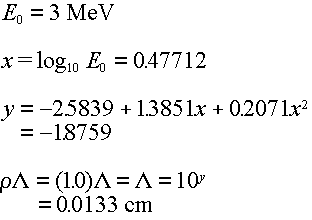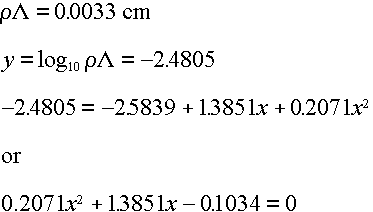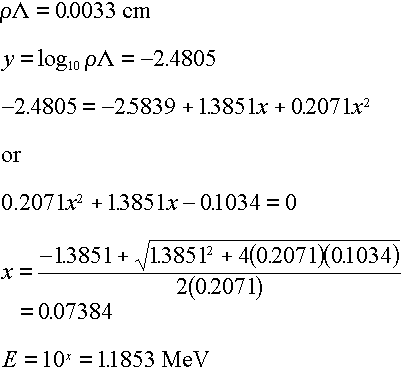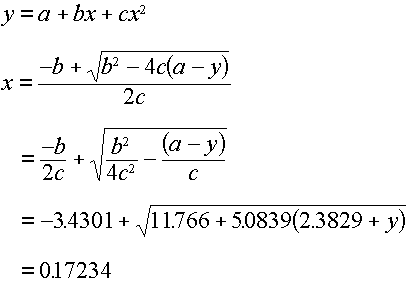|
Lesson 11 - Charged particle interactions
Our primary interest in this course is in the transport of neutral particles
-- primarily neutrons and gamma rays -- and in the dose effects this transport
causes. As we will see in future lessons, the effects on matter
of the transport of charged particles will generally be buried inside "response
functions" that we will apply to neutral particle flux densities.
What I expect you to get from the reading (Section 3.6) is:
-
Understanding of the difference between the basic model of charged particle
transport (continuous slowing down) and neutral particle transport (slowing
down from discrete collision sites with unperturbed travel between sites).
-
Ability to define range and stopping power (with the term "linear energy
transfer" or LET being synonymous with stopping power).
-
Use of Table 3.6 to get ranges for protons and electrons.
-
Ability to use the two rules on pages 71 and 72 to obtain rough estimates
of ranges of other particles, possibly in other materials.
The other type of problem that we will be solving involves use of the energy
remaining when a charged particle passes through a distance of material
thinner
than its range. We can use the range data in Table 3.6
to determine how much of its original energy it still has and, of course,
we can use this energy directly or in energy deposition calculations.
Note: We are assuming in these calculations that there
is a fixed, absolute range for a given particle in a particular material.
This is physically untrue, of course. The paths of different
particles will vary, with their average corresponding to their average
range. However, our assumption will allow us to get a rough estimate
of the physical features (ranges, energy deposited).
Range and energy calculations using Table 3.6 data
The rest of this lesson involves the use of the empirical formula coefficients
given in Table 3.6 in various calculations. The basic idea of these
relations is the following:
-
The range given by use of the Table 3.6 data can be used (with an appropriate
density value) to get the exact distance at which a given particle with
a given initial energy will come to rest. Therefore, if a particle tries
to penetrate a thickness of the given material thicker than its range,
it will not make it.
-
If a particle tries to penetrate a thickness of the given material that
is less than the range, it will penetrate it with reduced energy.
Here is the key point: The energy that the particle will have coming
out of the range is EXACTLY the energy that is required to penetrate the
"rest" of the range. For example, if a given particle of given initial
energy has a range that is 3 cm (in a given material), and it penetrates
a 2 cm thickness of that same material, it will exit the 2 cm thickness
with EXACTLY the energy that is required to penetrate 1 cm of that material.
-
If a particle with a given energy enters a material and the particle exits
with a lesser energy, the deposited energy in the material is (obviously)
the difference in the BEFORE and AFTER energies.
That's all there is to it. The rest is just in applying this simple
logic to given situations and wrestling with the logarithms and the quadratic
formula.
Example: A 3 MeV proton penetrates a 0.01 cm thickness of skin
(tissue). What energy is deposited in the tissue? (Assume a
skin density of 1 g/cc.)
Answer: The range of this particle in tissue is found from applying
Table 3.6 directly:

So, it will penetrate the 0.01 thickness, with exactly the residual
energy that would be needed to penetrate the "remaining" 0.0033 cm.
With this thickness, we work backwards (with the same data from Table 3.6)
to get:

We use the quadratic formula using the + for protons (since the Figure
3.15 proton data -- which is mislabeled as electron data -- is concave
upward, meaning that the "other" root would be to the left of the one we
want):

The energy deposited in the skin must be the difference between the
incoming and outgoing energy, 3-1.1853=1.8147 MeV.
Range and energy calculations for other particles and materials
Using the Table 3.6 data for protons penetrating aluminum, we can use some
simple approximations to estimate the ranges and energies of particles
other than protons impinging on materials other than aluminum. Here
is how it is done.
Given a non-proton ion projectile of energy E, mass m, and charge z
impinging on a material with atomic number Z and atomic mass A, the following
corrections are made:
-
:The "equivalent" proton energy is calculated as E/m. This is the
energy that you will use in Table 3.6. The reason for this adjustment
is that the simple approximations relate the penetration of projectiles
with the same speed, not the same energy.
-
Once the range (
 )
of the proton (with the "equivalent" energy) in aluminum is found from
Table 3.6 data, the range is adjusted: )
of the proton (with the "equivalent" energy) in aluminum is found from
Table 3.6 data, the range is adjusted:
-
If the particle is NOT a proton, the range is multiplied by
 to
account for the fact that heavier particles will penetrate farther into
any medium, but higher charged particles will penetrate less. to
account for the fact that heavier particles will penetrate farther into
any medium, but higher charged particles will penetrate less.
- If the material is NOT given in Table 3.6 we calculate the range
using the aluminum data in the table and then multiply the range by
 to adjust for the different electron density (i.e., electrons/unit
mass) of the material compared to aluminum.
to adjust for the different electron density (i.e., electrons/unit
mass) of the material compared to aluminum.
Use of these adjustments is best shown with an example.
Example: How much energy would a 10 MeV deuteron (m=2, z=1) deposit
in a 0.005 cm thick sheet of U-238 (Z=92, A=238)? (Use U-238 density
of 19.0 g/cc.)
Answer: Our procedure will be to make proper adjustments so that
we can use the proton-Al data from Table 3.6.
1. First we find the equivalent proton energy to be 10/2 or 5 MeV.
2. Next we find the range of the proton in aluminum:

3. Now we use the multipliers to get the range of a deuteron in U-238:


By the problem statement, we have to determine the deuteron energy after
it emerges from the 0.005 cm plate. At this distance into the U-238,
it must have EXACTLY as much energy as it would take to penetrate the remaining
0.00594-0.005=0.00094 cm. So, we must now find out how much energy
that is.
4. We translate the 0.00094 cm back to the equivalent proton range in
Al by multiplying by the U-238 density and DIVIDING by the range multipliers:

5. Now we work backwards through Table 3.6:


(By the way, you might want to jot down the equation in the next-to-last
line above; it might come in handy on the test. Remember, though,
that it only applies to protons impinging on aluminum.)
6. This gives a proton energy of  ,
which correspons to a deuteron energy of twice this, or 2.974 MeV. ,
which correspons to a deuteron energy of twice this, or 2.974 MeV.
Therefore, the deposited energy in the plate is 10 - 2.974 = 7.026 MeV.
|
 NE406 Radiation Protection and Shielding
NE406 Radiation Protection and Shielding NE406 Radiation Protection and Shielding
NE406 Radiation Protection and Shielding